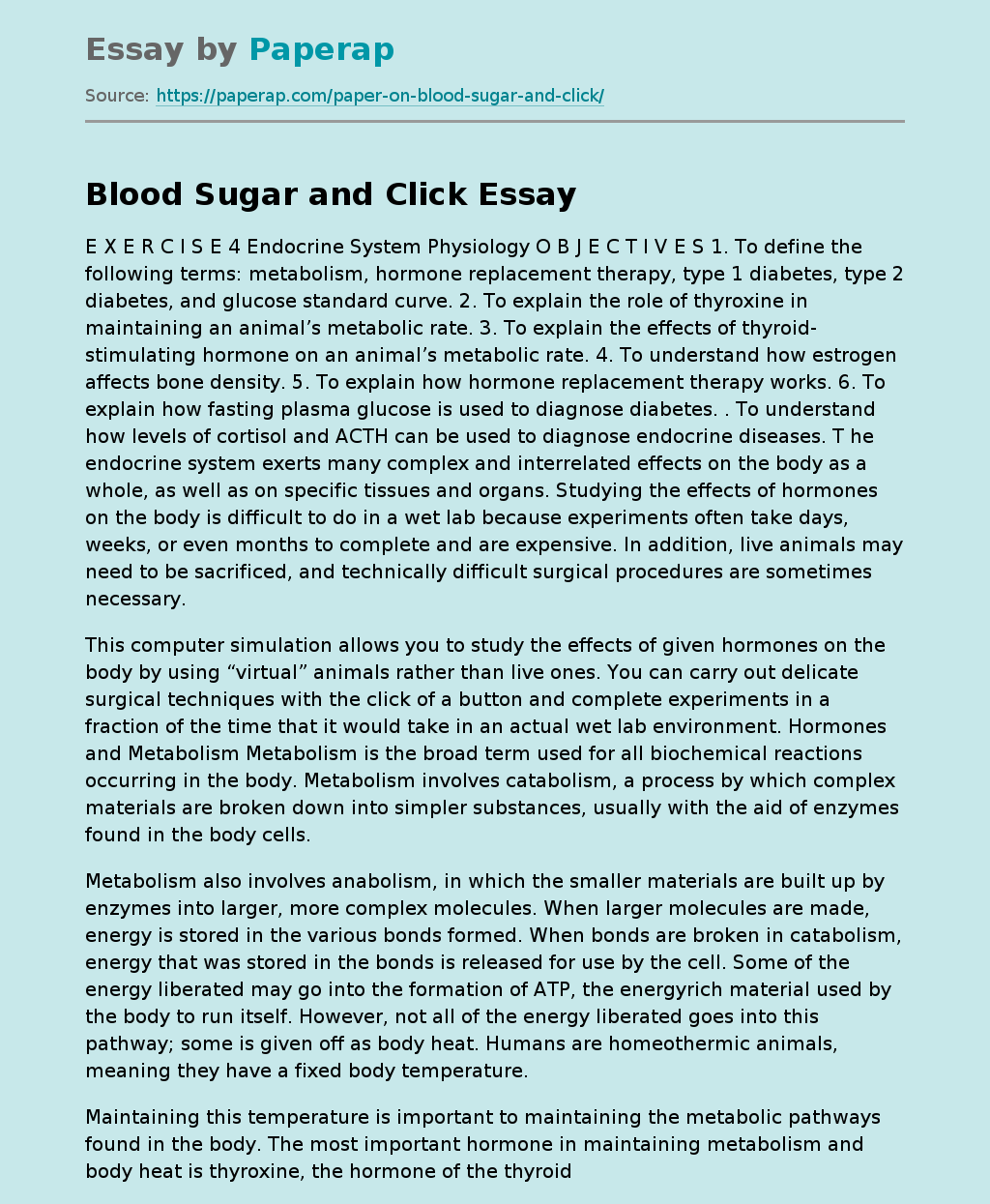Blood Sugar and Click
This computer simulation allows you to study the effects of given hormones on the body by using “virtual” animals rather than live ones. You can carry out delicate surgical techniques with the click of a button and complete experiments in a fraction of the time that it would take in an actual wet lab environment. Hormones and Metabolism Metabolism is the broad term used for all biochemical reactions occurring in the body. Metabolism involves catabolism, a process by which complex materials are broken down into simpler substances, usually with the aid of enzymes found in the body cells.
Metabolism also involves anabolism, in which the smaller materials are built up by enzymes into larger, more complex molecules. When larger molecules are made, energy is stored in the various bonds formed. When bonds are broken in catabolism, energy that was stored in the bonds is released for use by the cell. Some of the energy liberated may go into the formation of ATP, the energyrich material used by the body to run itself.
However, not all of the energy liberated goes into this pathway; some is given off as body heat. Humans are homeothermic animals, meaning they have a fixed body temperature.
Maintaining this temperature is important to maintaining the metabolic pathways found in the body. The most important hormone in maintaining metabolism and body heat is thyroxine, the hormone of the thyroid gland, which is found in the neck. The thyroid gland secretes thyroxine, but the production of thyroxine is really controlled by the pituitary gland, which secretes thyroid-stimulating hormone (TSH).
TSH is carried by the blood to the thyroid gland (its target tissue) and causes the thyroid to produce more thyroxine. So in an indirect way, an animal’s metabolic rate is the result of pituitary hormones.
You will see a jar-shaped chamber to the left, connected to a respirometer-manometer apparatus (consisting of a U-shaped tube, a syringe, and associated tubing). You will be placing animals—in this case, rats—in the chamber in order to gather information about how thyroxine and TSH affect their metabolic rates. Note that the chamber also includes a weight scale, and under the timer is a weight display. Next to the chamber is a timer for setting and timing the length of a given experiment. Two tubes are connected to the top of the chamber. The left tube has a clamp on it that can be opened or closed.
Leaving the clamp open allows outside air into the chamber; closing the clamp creates a closed, airtight system. The other tube leads to a T-connector. One branch of the T leads to a fluid-containing U-shaped tube, called a manometer. As an animal uses up the air in the closed system, this fluid will rise in the left side of the U-shaped tube and fall in the right. The other branch of the T-connector leads to a syringe filled with air. Using the syringe to inject air into the tube, you will measure the amount of air that is needed to return the fluid columns to their original levels.
This measurement will be equal to the amount of oxygen used by the animal during the elapsed time of the experiment. Soda lime, found at the bottom of the chamber, absorbs the carbon dioxide given off by the animal so that the amount of oxygen used can easily be measured. The amount of oxygen used by the animal, along with its weight, will be used to calculate the animal’s metabolic rate. Also on the screen are three white rats in their individual cages. These are the specimens you will use in the following experiments.
One rat is normal; the second is thyroidectomized (abbreviated on the screen as Tx), meaning its thyroid has been removed; and the third is hypophysectomized (abbreviated on the screen as Hypox), meaning its pituitary gland has been removed. The pituitary gland is also known as the hypophysis, and removal of this organ is called a hypophysectomy. To the top left of the screen are three syringes with various chemicals inside: propylthiouracil, thyroid-stimulating hormone (TSH), and thyroxine. TSH and thyroxine have been previously mentioned; propylthiouracil is a drug that inhibits the production of thyroxine.
Check that the data set for Normal is highlighted in the Data Sets window; you will be experimenting with the normal rat first. The Record Data button lets you record data after an experimental trial. Clicking the Delete Line or Clear Data Set button erases any data you want to delete. A C T I V I T Y 1 Determining Baseline Metabolic Rates First, you will determine the baseline metabolic rate for each rat. 1. Using the mouse, click and drag the normal rat into the chamber and place it on top of the scale. When the animal is in the chamber, release the mouse button. . Be sure the clamp on the left tube (on top of the chamber) is open, allowing air to enter the chamber. If the clamp is closed, click on it to open it. 3. Be sure the indicator next to the T-connector reads “Chamber and manometer connected. ” If not, click on the T-connector knob. 4. Click on the Weigh button in the box to the right of the chamber to weigh the rat. Record this weight in the Baseline section of Chart 1 in the row labeled “Weight. ” 5. Click the ( ) button on the Timer so that the Timer display reads 1 minute. 6. Click on the clamp to close it.
This will prevent any outside air from entering the chamber and ensure that the only oxygen the rat is breathing is the oxygen inside the closed system. 7. Click Start on the Timer display. You will see the elapsed time appear in the “Elapsed Time” display. Watch what happens to the water levels in the U-shaped tube. 8. At the end of the 1-minute period, the timer will automatically stop. When it stops, click on the T-connector knob so that the indicator reads “Manometer and syringe connected. ” 9. Click on the clamp to open it so that the rat can once again breathe outside air. 10.
Look at the difference between the levels in the left and right arms of the U-shaped tube. To estimate the volume of O2 that you need to inject to equalize the levels, count the divider lines on both sides. Then click the ( ) button next to the ml O2 display until the display shows your estimate. Click Inject and watch what happens to the fluid in the two arms. When the volume is equalized, the word “Level” will appear between the arms and stay on the screen. If too little was injected, click ( ) and then Inject until the arms are level. If too much was injected, the word “Level” will flash and then disappear.
Blood Sugar and Click. (2018, Aug 12). Retrieved from https://paperap.com/paper-on-blood-sugar-and-click/

